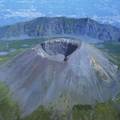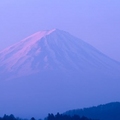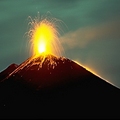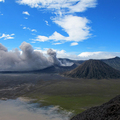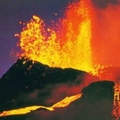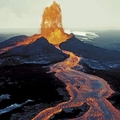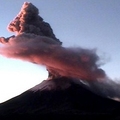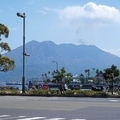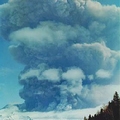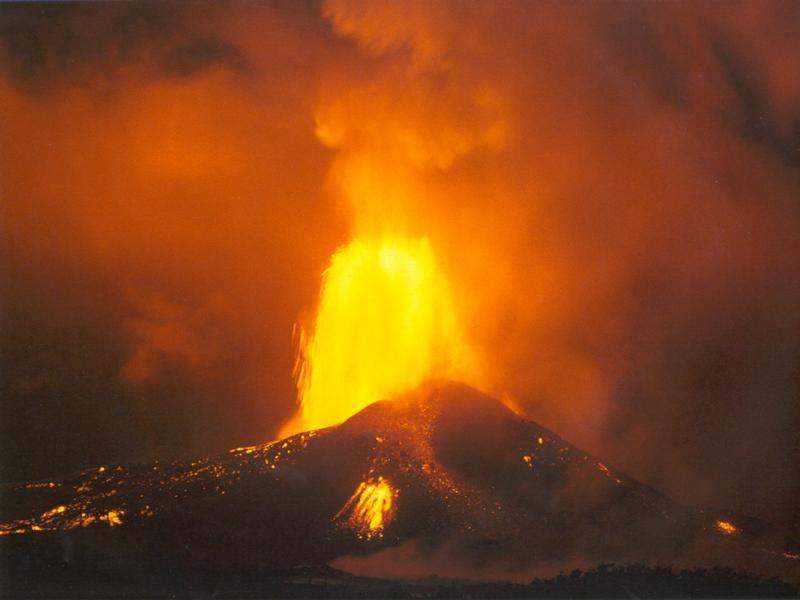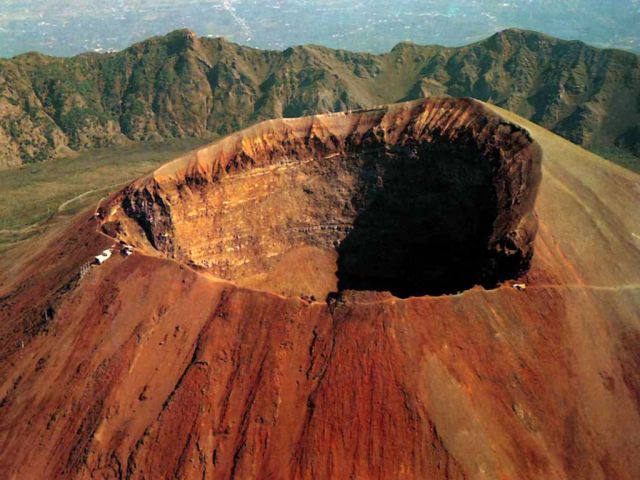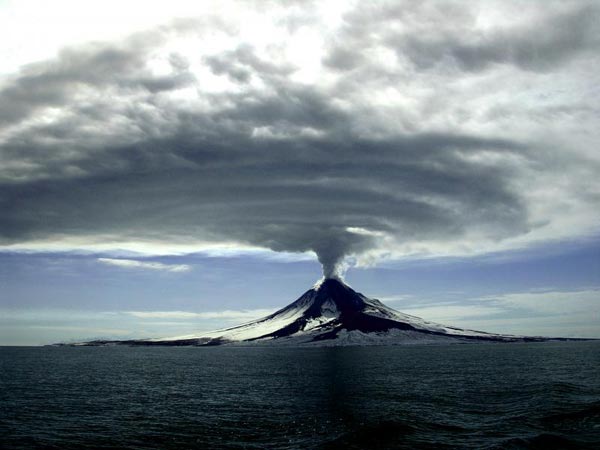Eco-friendly locations / The Best Volcanoes to Visit in the World / Vesuvius
Vesuvius
Vesuvius is, by no means, one of the most dangerous and most famous volcanoes in the world, because it is almost 2000 years old. This volcano killed one of the cities of the Roman Empire, known to all as Pompeii. Vesuvius was a picturesque mountain, majestic over the Gulf of Naples, rising to 1,300 meters above the sea level. But early in the morning on August 24, 79 a cloud of unusual shape appeared. If you compare it with the trees, more than anything else it was like the Italian pine. A huge pine trunk heaving up and diverging into the top of their branched crown, which seemed to support the updrafts. Then, as if the stream ran dry, the trunk began to dissolve, at times becoming white, the color getting dirty. It depended on the volcano which threw ash or ground.
History
So it was described in a letter to the Roman historian Tacitus about the eruption of Mount Vesuvius. The Roman writer, Pliny the Younger, who was visiting Miseno at that time, the estate of his uncle on the shore of the Bay of Naples. Although the letter primarily dealt with the death of his uncle and the patron of Pliny the Elder, it is nevertheless an important document. At first, few people paid attention to the rising above of the volcano cloud of ash and steam. Till the I century AD Romans believed that their volcano on Mount Vesuvius was dormant. But the day came on August 24,when regular gladiators were assigned. In the afternoon Pliny the Elder’s sister noticed a cloud, a club of Vesuvius. The sky suddenly became threatening, the clouds grew darker and darker ... Abundant ash fell, the sun was completely hidden and there was total darkness. This further increased anxiety and confusion among people. It was impossible to go out in the street without covering the head with a pillow, as ashes and heavy stones were falling on people. By 79 AD, Pliny the Elder, the Roman fleet commander in the north-western part of the Bay of Naples ordered to prepare the ship, which would go to the point of the eruption . Meanwhile, envoys from the villages came at the foot of the mountain and cries for help had already begun to be heard. Pliny changed his plans and ordered to put a few courts, in case evacuation will be needed. The rest of the court, he sent to the villages, as he headed towards the volcano. Underestimating the scale of the disaster and the power of the raging Vesuvius, showing "his fearlessness," before fleeing in panic the residents of Stabiae, Pliny the Elder died on the third day of the eruption. Pompeii was located close enough to the volcano. Wealthy people understand in time than they could face the eruption began, and quickly tried to escape to safety. Only those who did not believe in the catastrophe didn’t have time to evacuate Herculaneum and Pompeii.
The Great eruption
The eruption of Vesuvius destroyed Pompeii completely. The city disappeared under a layer of ash that reaches a thickness of three meters. When in the middle of the XVIII century, excavations of Pompeii began, skeletal remains of many people who died were found in the alley. Many people attached to the loved ones or to valuable things had been killed. The owners of the famous Faun house, instead of saving his life, lost a lot of time on the packaging of jewelry. Located on the other side of Vesuvius, Herculaneum city was filled with ashes falling from the sky, but it too was doomed and vanished from the Earth. High on the slopes of the volcano a huge amount of ash accumulated, which threatened to fall down at any moment. And when rain was pouring, the weight of ash soaked and began to slump. The depth of some of these flows reached fifteen feet. But by the time most people had already left the city. The residents of Pompeii element spared until the next day, when a new eruption of Mount Vesuvius shot up clouds of ash and deadly gas. Supposedly 2000 people were killed in Pompeii that day, but the number was constantly being revised, as in the vast area of excavation, archaeologists seek the remains of all the new victims. However, the Italian archaeologists discovered a more ancient settlement on the site of Pompeii. The head of the excavations, Professor Giuseppe Vechchio said that the settlement was found (near the modern village of Nola) which was inhabited in the period before 1800 BC, when it suffered the same fate . Archaeologists have found a settlement called the "Pompeii of the Bronze Age." Archaeologists have so far not specify what findings were made in the cultural layer "Bronze Age Pompeii". It was reported only that some utensils and remains of buildings, as well as rare fossils had been found. Scientists point out that the cultural layer "Bronze Age Pompeii" contains a large amount of petrified volcanic ash and lava, which, according to archaeologists, indicates that the settlement was probably destroyed by the eruption of Vesuvius in about 1800 BC . The height of Vesuvius is of 1277 m, which is less than half the height of the Mount Etna - the largest volcano in Europe, but the viscous lava makes it considerably more volatile. The sulfur pair is constantly rising over the huge main crater, and the soil in areas close to the top is so hot that it can bake eggs. And in the crater and on the fresh lava flows. The water vapor and gases reach temperatures up to 400 ° C! The first (and the most famous) recorded eruption of Vesuvius in 79 AD caused a collapse of the old crater. A new scyphiform crater called a caldera was formed, within which stood a new one, a smaller cone. The last major eruption occurred in 1944, and after walking on foot or by cable car to the edge of the crater would seem that the volcano is tamed, but the clouds of smoke over the vents and volcanic dust in the towns at the foot of a reminder that the eruption may begin at any time. That is why the volcano is located near the laboratory, which monitors the activity of this beautiful, but terrible eruption of the famous volcano called Vesuvius.
Maps of Vesuvius
map ItalyOthers from The Best Volcanoes to Visit in the World
A volcano is formed by a non-visible internal structure of the crust including magma chamber , magma pipes and a visible structure.
More commonly, the term volcano refers only to the outside and the visible part to the right of the volcanic relief , more or less conical, consisting of all those materials, liquid, solid or gaseous fuels, which were issued from the craters during the various stages of the eruption of the volcano itself.
The masses of rocks which form a volcano are called igneous rocks , as derived from the cooling of the magma ascended from the Earth .
The shape and the height of a volcano depend on several factors including the age of the volcano, the type of the eruptive activity, the type of the released magma and the characteristics of the underlying volcanic structure.
In general volcanoes are discontinuities in the Earth's crust through which all various events and magmatic endogenous products: powders, gases, vapors and solid volcanic material is casted.
The release of this material is erupting and the erupted materials are lava , ash , gas , slag and various water vapors .
On the surface, 90% are submarine volcanoes (mostly located along the dorsal mid-ocean), while about 1500 volcanoes are now active on land.
Description What is commonly called a volcano, technical terminology is defined in the volcano or volcanic cone , but since the term most used is the volcano.
The volcano is often named in geology .
The volcanoes testify to the existence, in the deep zones of the lithosphere , the molten masses of silicate are called natural magmas .
A generic volcano is formed by: a magma chamber or a magma basin, fed by magma , when it is empty after an eruption.
A volcano may collapse and create a caldera .
The magma chambers are located between 10 and 50 km depth in the lithosphere .
a stack or a duct volcanic main crossing point of the magma from the magma chamber to the surface.
a crater summit, where the main pipe flows.
one or more secondary ducts, which, flowing from the flanks of the volcano or the same basis, give life to the secondary cones.
lateral cracks, fractures on the longitudinal side of the volcano, caused by the pressure of the magma.
They allow the escape of lava in the form of eruption.
For their grandeur of the event the volcanoes are an object of admiration, of fear, of curiosity and of study since the antiquity with different interpretations created to explain its origin.
Plato admitted the existence of an underground river of fire.
Seneca indicated as the cause of eruptions and earthquakes, the penetration of water into the ground, when the water reached the incandescent matter, vapors under high pressure.
In 79 AD ,Pliny the Younger described the eruption of Vesuvius that buried Pompeii , Herculaneum and Stabiae.
But the real science that studies volcanoes, the volcanology ,was born only in the seventeenth century , when the naturalists were interested in the eruptions of Vesuvius ( in 1631 ) and of Etna ( in 1669 ).
This science is more decisive in progress with the studies of Spallanzani and then in the nineteenth century , with the help of petrography .
The origin of volcanoes is explained by various theories, including two important, but opposite theories: the theory of craters of lifting De Buch ; the theory of external accumulation of Scrope and Spallanzani .
In the theory of De Buch, volcanoes would have originated from the magma which would raise the outer layers of the Earth forming the cone, which then would break up to form the craters.
In the second theory, the volcanoes would be due to the accumulation of the solid material emitted or projected from the volcanic conduit.
The heat that is produced inside exerts a pressure evenly over the crust, thinner where the magma would surrender, letting it , causing the birth of the volcanoes.
The classification of volcanoes The volcanoes can be classified according to the type of external device or the type of the volcanic eruptions, both of these characteristics being closely linked to the composition of the magma and the magma chamber (and thus emitting lava).
This classification is called Lacroix Classification by the French geologist Alfred Lacroix who first conceived.
Depending on the type of the volcanic external apparatus Considering the type of the volcanic cone there are 2 types of volcanoes: 1.
Shield volcanoes 2.
Cone volcanoes Shield volcanoes A shield volcano has moderately sloping sides, and it is built by the eruption of the lava basalt fluid.
The basaltic lava tends to build enormous cones low slope, because its low viscosity allows it to slide smoothly on the ground or under it, in the lava tubes, up to many kilometers without significant cooling.
The major volcanoes of the world are the shield volcanoes.
The name comes from the same geometry, which makes them look like shields resting on the ground.
The largest shield volcano in the world is in Hawaii , its name is Mauna Loa .
It measures about 4000 m above the sea level , but its base is located at 5000 feet below the sea level, so its actual height is of 9000 meters, while its base diameter is about 250 km.
Cone volcanoes We find a volcano cone when the lava is acidic.
In these cases, the magma is very viscous and it is difficult to trace, solidifying quickly once outside.
Emissions flow and alternate with the solid material that is shot out and alternate with the cast, as the layers of the building.
The eruptions of this type can be very violent (like that of Vesuvius that buried Pompeii ), because the magma tends to obstruct the volcanic chimney creating a "cap" only when the internal pressures are sufficient to overcome the obstruction, the eruption resumed ( the eruption of Vulcan type), but in extreme cases there may be an explosion that may come to destroy the entire volcano ( Peleus).
The volcanism of this type is present along the continental margin of the pits or arc-trench systems, where the magma comes from the crust where the rocks are more of an exogenous composition.
Depending on the type of the eruptive activity Broadly speaking we distinguish red volcanoes (volcanoes characterized by effusive emissions in which the accumulation of the volcanic lava flows gives the building looks "reddish brown"), and gray volcanic (eruptions of volcanoes with explosive character in which the accumulation of ash give the building looks gray-black volcanic).
Specifically, considering the type and the power of the eruption of a volcano you have: 1.
Hawaiian volcanoes in eruption type 2.
Volcanoes in eruption of Icelandic type 3.
Strombolian volcanoes in eruption type 4.
Volcano eruption at Vulcan type 5.
Volcano eruption at Vesuvius type 6.
Plinian eruptions at volcanoes and Pelean type 7.
Large calderas ("super-volcanoes") Hawaiian Type The eruptions are not related to the tectonic movements that are due to the plaque but rather to see the phenomena the magma plumes from the back to warm up the hot spots.
The summit of the volcano is occupied by a large depression called caldera , bounded by steep walls due to the collapse of the fund.
Others occur within the caldera collapses, creating a well structure .
The lava is very basic and therefore very fluid, it produces the typical volcanic edifices form a "shield , with weak slopes of the mountains.
Icelandic type They are also called volcanic fissure eruptions which occur through long slits and not by a circular crater.
The casting, basic and the ultra basic magmas fed by, tend to form the highland basalt (basalt plateaus).
At the end of an eruption fissure (or linear), the eruptive fissure may disappear since it is covered by lava and solidified spill, does not reappear until the next eruption.
The best examples are found in Iceland , from which the special designation of the type, an excellent example of the Icelandic volcano eruption is that of Laki of 1783 , one of the most famous volcanic eruptions in the history of the European Union .
Strombolian type Very viscous basaltic magmas give rise to an enduring characterized by emissions at regular intervals and fragments of lava fountains that reach hundreds of meters high, and the launch of lava and volcanic bombs.
The fallout of these products creates scoria cones from the quite steepides .
Stromboli , the island-volcano from which it takes its name, this kind of effusive activity, has been in business for two millennia, much to be known, since the time of the earliest civilizations as the " lighthouse of the Mediterranean .
" Type Vulcan They were named after the island of Vulcano in the archipelago of the Aeolian Islands .
They are explosive eruptions during which lava bombs release clouds of gas and ash laden.
The explosions can produce fractures, ruptures of the crater and the opening of lateral vents.
Vesuvius type From the name of the volcano Vesuvius , it is similar to the Vulcan, but with the difference that the initial explosion is tremendously violent enough to drain most of the magma chamber: the magma from deep zones, then back up at high speed out of the crater and dissolve in tiny droplets.
When this type of eruption is at its most violent it is called Plinian eruption (in honor of Pliny the Younger who first described the course in 79 AD).
Plinian type The eruptions are produced by very viscous magma .
Hot clouds are frequently formed from gas and pulverized lava.
They are very dangerous eruptions ending usually with partial or total collapse of the volcano or the release of a plug of lava that of a volcanic plug or dome .
In some cases both phenomena occur.
The volcanic eruption that exhibits this behavior are characterized by the shape of a cone.
These eruptions are named for Pliny the Younger who first described this type of eruption observing the eruption of Vesuvius in 79 AD, which submerged Pompeii and Herculaneum in ashes .
A variant is the Plinian eruption : if during a Plinian eruption the main body of the glowing cloud released from the crater summit during an eruption peleana (which takes its name from the volcano 's Pelee in Martinique ) , the volcano erupts from the crater, but not centrally splitting up the side of the volcano.
This eruption has devastating effects concentrated in the direction of the main eruption of a glowing cloud that can reach more than 20 km from the building volcanic (as happened in 1980 in the eruption of St.
Helens ).
Other variants of the Plinian eruptions are the ultra-plinian : these eruptions are characterized for having an even bigger explosion, which may come to completely destroy the volcanic edifice (it is an example of the Krakatoa or Santorini ), and above all for the enormous amount of the released volcanic ash.
The explosion of this type, based on the large amount of ash that remains in suspension in the atmosphere, has a greater or lesser impact on the global climate in the years following the eruption.
Large calderas Although not recognized as true volcanoes, they deserve a separate mentioning: the case of 7-8 large calderas identified on the surface.
These structures are characterized by not having a volcano rather than a depression of volcanic origin (known as Caldera), which covers a vast area, more than 10-15 km.
Inside the caldera, you can see the development of various craters formed more or less.
It was never observed an eruption of this type of calderas (which have periods of eruption of hundreds of thousands of years) and these areas are now subject only to a minor type of volcanism (geysers, fumaroles, hot springs, .
.
.
).
The best known examples of this type of equipment is the park of Yellowstone , The Phlegraean Fields , the Alban Hills , the Toba Lake .
Activities of volcanoes The magma rises through the mantle or less dense than the Earth's crust because of the surrounding rocks (lifts for buoyancy ).
During the ascent, due to the decrease in pressure , the gases dissolved in the melt dissolve a further decrease of the density .
The magma in the crust can build up, to cool and solidify, or climb up to the surface of the earth thus giving rise to an eruption .
The eruptions may be of different types: they can give rise to explosive phenomena, where ash and lapilli are projected up to tens of kilometers above the crater and deposited up to hundreds of miles away from the eruptive center, or effusive, if the magma flows, forming a lava flow that propagates to shorter distances (tens of meters to a few km from the eruptive center).
One of the characteristics that influences the type of the eruption is the viscosity of the magma, which depends on the content of silicon , which binds with the oxygen molecules that form always tend to bond with each other and form indestructible chains.
If the magma has more than 60% silica [SiO2] it is considered viscous and more likely to give rise to an explosive eruption, but if the magma has less than 50% silica it is likely to be erupted with dynamic and effusive emitted lava as flows.
Here is a presentation of the most famous and the most popular volcanoes in the world.
Of course, I referred to their power of eruption, their activity and their beautiful environment provided to visitors.
Volcanoes represent huge interest to people, not only for the fact that they are dangerous but for many other reasons too.
Discover the most famous volcanoes in the world.

